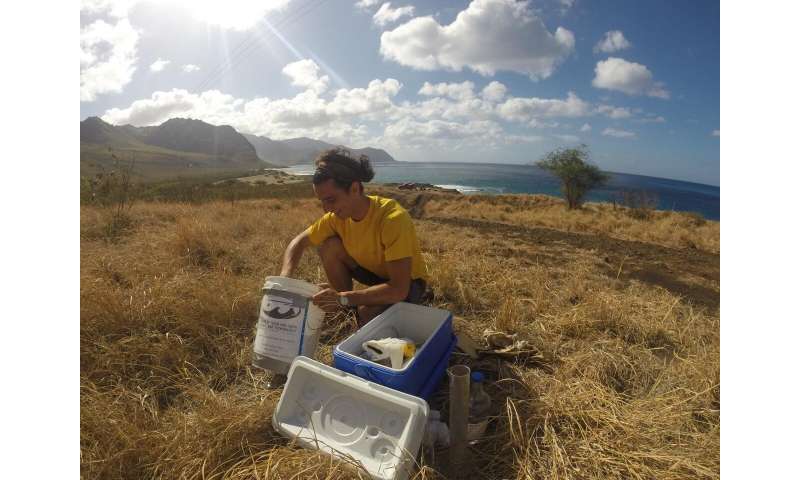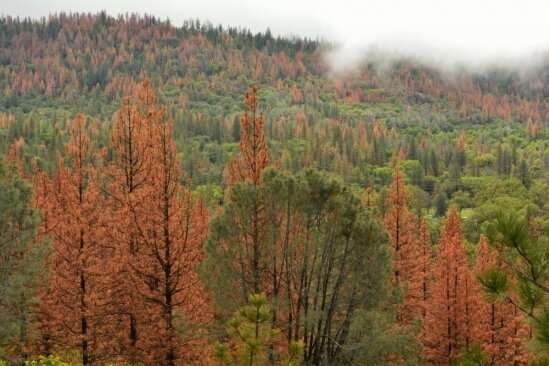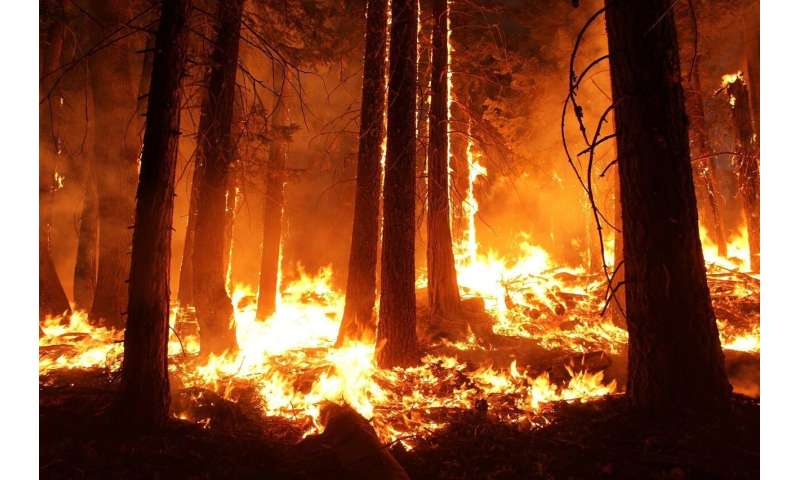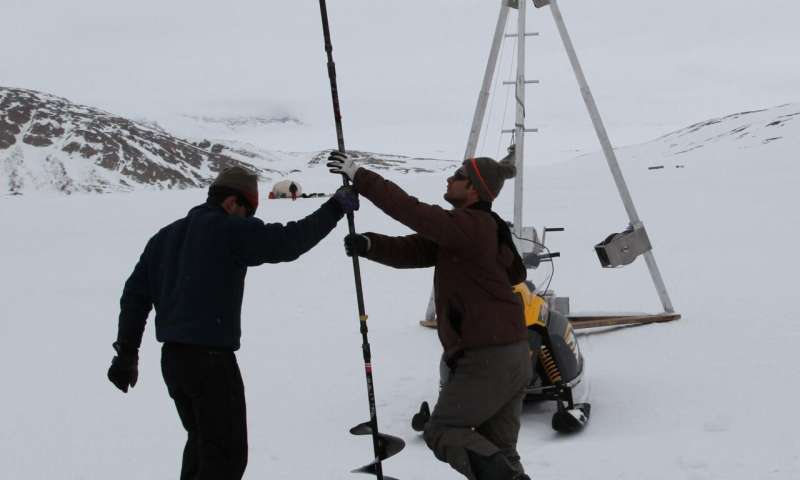Eastern Pacific is a major supply chain for illegal shark fin trade, researchers find
by Angela Nicoletti, Florida International University

Credit: Florida International University
New research reveals the Eastern Pacific is a particular hotspot for the shark fin trade—and a danger zone for an endangered species fighting for survival.
Florida International University (FIU) postdoctoral researcher Diego Cardeñosa and Demian Chapman, an associate professor of biological sciences and marine scientist in the Institute of Environment, collaborated with scientists in Hong Kong to track and monitor the global shark fin trade using DNA testing.
They tested fins from endangered pelagic thresher sharks (Alopias pelagicus)—a species commonly found in the fin trade. Almost 85 percent of fins sampled from retail markets in Hong Kong and China were genetically traced back to sharks caught in the Eastern Pacific. It's not the first time the scientists have linked fins from endangered sharks to this specific area.
"The findings weren't surprising, because earlier this year we discovered the majority of fins from endangered scalloped hammerhead sharks also originated from the Eastern Pacific," Cardeñosa said. "This is a region with poor fisheries management and poor capacity to enforce international regulations."
The Eastern Pacific—which extends from Baja, California to Northern Peru—features island chains including the Galapagos and Cocos. The region attracts tourists. More recently, it's also attracted a growing presence of Chinese industrial fishing vessels, especially near the Galapagos. One of the primary reasons pelagic thresher shark populations are in steep decline is because of fishing practices that involve longlines and gillnets.
The researchers traced the fins back to the Eastern Pacific by comparing DNA from the fin trimmings in Hong Kong's markets to genetic samples that were previous collected from the region.
While pelagic thresher sharks are considered a single species, there are actually two "clades" or separate populations that exist. These groups don't intermingle. Instead, they mate within their specific clade. This means there are two different genetic populations—a Western group that resides in the ocean between Taiwan and Hawaii and an Eastern group, which roams between Hawaii eastward toward the coast of the U.S., Mexico, Costa Rica and Ecuador. The majority of the samples tested were from sharks that had belonged to the Eastern group.
Thresher sharks are protected under Convention on International Trade in Endangered Species of Wild Fauna and Flora (CITES)—an international agreement protecting animals and plants from over-exploitation in international trade. All trade of these sharks requires permits certifying they were legally caught and traceable through the supply chain. Since 2017, CITES permits have documented more than five tons of shark fins exported from the Eastern Pacific to Hong Kong. This only captures legal fishing operations. Alongside the legal trade, illegal trade is also happening.
"Our research pinpoints the Eastern Pacific as a major supply chain starting point for thresher sharks and other threatened sharks, and also a high-risk region for illegal trade," Cardeñosa said. "With what we know, we can begin to guide intervention efforts to monitor and enforce international laws. It's especially important to use all available technology and tools to detect and deter illegal trade of CITES-listed species."
Cardeñosa and Chapman remain committed to combating illegal trade with their DNA detective work. Earlier this year, Hong Kong customs officials intercepted an illegal shipment from Ecuador—in the Eastern Pacific—of 26 tons of thresher shark fins. The secret tool behind this historic seizure of shark fins was a DNA testing kit co-developed by Chapman and Cardeñosa. Created with funding from the Paul G. Allen Family Foundation, it's being used in airports and shipping ports to help customs officials identify protected shark species.
"There is a tendency for people to focus on the fin markets when looking for solutions to this problem, but our work shines light on the regions where most fins are coming from and hence where shark conservation and fisheries management could make a real difference on the ground," Chapman said. "We will only progress on global shark conservation by working throughout the supply chain—from ocean to markets."
The research is supported by the Pew Charitable Trusts and the Pew Fellowship Program. The findings were published in Animal Conservation. Cardeñosa was recently named a Distinguished Postdoctoral Fellow in the College of Arts, Sciences & Education.
FIU is ranked No. 9 in the world for positive impact on life below water by The Times Higher EducationImpact Rankings. The university ranked third in the United States and is the only institution in the state of Florida to make the list.
Pandemic forces youth climate activists to save the planet on Zoom
by Megan Calfas, Los Angeles Times

The 20-year-old South Los Angeles local was one of millions who had taken to the streets in a primarily youth-led effort to demand action against climate change during a week of global climate strikes.
"It was just quite, quite amazing," Patel recalled recently.
Today, however, as that watershed moment for a generation of young climate change activists recedes into history, Patel and others are facing a very different organizing landscape due to a global pandemic and national upheaval over police killings of Black men and women.
In the midst of stay-at-home orders brought on by the coronavirus pandemic, youth climate leaders across the country are juggling online school and Zoom fatigue, while still attempting to take action against the climate crisis and raise awareness about the inequities it amplifies. Many youth climate activists have also shifted focus toward showing up in solidarity for Black Lives Matter protests, while putting a pause on in-person organizing of their own.
It's been hard, but they haven't stopped working.
"We're still here and we're not backing down," said Patel, who is now living at home with his parents while Zooming into virtual classes at Loyola Marymount University.
The Global Climate Strike effort grew out of Fridays for Future, an organization started by Greta Thunberg, the 17-year-old Swedish climate activist.
This year, Fridays for Future held a global day of climate action on Sept. 25, with "online and offline" actions in 154 countries, following respective COVID-19 limitations.
Chandini Agarwal, 16, communications director of Youth Climate Strike L.A., said that since the pandemic began, their group has been striking online and embracing a different goal: "The online protest is more about getting the people who are involved enthusiastic and energized about the cause. But it doesn't actually disrupt the status quo of everyday life of civilians."
Agarwal thinks that level of disruption must be sustained in the Black Lives Matter movement. She's showing up every Wednesday she can to the weekly protests outside the Hall of Justice in Los Angeles.
Patel is also showing up to Black Lives Matter protests.
"I know if I don't go and I don't show my solidarity, then these injustices are just going to keep happening," he said. Patel protests with an extra eye toward safety, given that he has heart arrhythmias, making him more vulnerable to COVID-19. He developed this condition at age 12 and his doctors believe it may be linked to the high level of air pollution in his community in South L.A.
"When we're looking at the climate crisis, we're not only looking at warming of the planet, we're looking at how BIPOC (Black, Indigenous, and People of Color) communities are being most affected right now," Patel said. "We love to separate the issues of climate justice and social justice, but that's just wrong."
In this age of coronavirus restrictions, teen activists with the international organization Extinction Rebellion have embraced street art as a new way to show up, posting fliers and stickers across Los Angeles in an act of "socially distant civil disobedience," according to Kori Malia, 22, a national outreach coordinator for their L.A. chapter.
Online events have also been a success, organizers say. In April, for the 50th anniversary of Earth Day, a coalition of L.A.-based climate justice organizations came together under the name MVMT-LA and led a four-day action. Even online, it felt meaningful and connective. "We wanted to make sure this would not be just another rally or another virtual event, no, this was going to be how we pray," said Lex Saez, founder of the L.A. chapter of the International Indigenous Youth Council.
Many current youth climate activists got their start, or newfound momentum, at one of last fall's protests.
Malia said that being there made her realize that people could be powerful in a way that was "not just in the history textbooks, but something I was living in real time."
Ozzy Simpson, 19, organized a walkout at his high school in Pasadena as part of the effort. It was his first time organizing for climate action and, unexpectedly, about 500 people showed up. "Turning the corner and seeing that many people was really surprising and kind of humbling."
Now, Simpson is taking a gap year and working full time as a founding member of the Sunrise Movement's L.A. Youth hub. Most of their activism happens online, through Twitter storms and long Zoom planning meetings, but they do occasionally escalate to in-person, socially distant actions. Most recently, some members of Sunrise L.A. Youth protested outside CNN's Los Angeles office to "demand that they connect the climate crisis with the wildfires, with the hurricanes."
The August-September heatwave and the ongoing, historic wildfires are generating urgency as well.
Saez said the fires should be seen as "a cry for help. Mother Earth needs help."
"In moments like these, we really must rethink the way we live on the land and set our priorities straight," said Yulu Wek, 22, member of the International Indigenous Youth Council.
When the Bay Area woke up to orange skies last month, Lizbeth Ibarra, 15, said the first thing she did was reach out to fellow members of Youth vs. Apocalypse, an Oakland-based, youth-led climate justice organization.
They group-texted about how crazy it was, then quickly sprang to action. Within a few hours, they released a video. In it, lead members of the organization filmed themselves on selfie-view, in front of windows that are orange frame-to-frame: "Three years ago, when we decided our name would be Youth vs. Apocalypse, people literally laughed in our faces. As you can probably tell, the literal apocalypse is outside my window."
To do this work, youth climate activists stay busy—really busy. Patel squeezes in appearances on virtual panels and Instagram Lives between his online classes.
Sarah Goody, 16, has found new possibilities in multitasking: "I can kind of do my activism during class, which I know I'm probably not supposed to do." Goody is Zooming into sophomore year at her high school in Marin County and running the organizations she founded, Climate NOW and Broadway Speaks Up. "You've got the Zoom call in one tab and then on the other tab I'm responding to emails, putting together graphics, sending out different newsletters."
Joe Hobbes, 17, an organizer for Fridays for Future, is taking both high school and community college classes online, organizing for the movement, and working as a barista. "It's a tricky day schedule," he said.
"It's not easy," said Ibarra. "I mean, we're all teenagers. We have our own lives too. We have school, we have a lot to juggle. But, you know, we're still in a global climate crisis."
Environmental activism goes digital in lockdown—but could it change the movement for good?
©2020 Los Angeles Times
Distributed by Tribune Content Agency, LLC.
9 shares
Hurricanes, heavy rains are critical for Hawai'i's groundwater supply
by Marcie Grabowski, University of Hawaii at Manoa

Daniel Dores, lead author preparing rainfall collection equipment, West O'ahu. Credit: Michael Mathioudakis, UH Manoa
Located within the most isolated archipelago in the world, Hawai'i is critically dependent on a clean, ample supply of fresh water. New research led by University of Hawai'i at Mānoa scientists indicates that rain brought to the islands by hurricanes and Kona storms can often be the most important precipitation for re-supplying groundwater in many regions of the island of O'ahu.
"The majority of Hawai'i's freshwater comes from groundwater," said Daniel Dores, lead author and groundwater and geothermal researcher in the UH Mānoa School of Ocean and Earth Science and Technology. "In this study, we investigated the relationship between trade wind showers, major rainfall events like Kona storms, and groundwater."
Dores and a team of scientists from SOEST and the Hawai'i Department of Health collected rainfall around the island of Oahu and analyzed the stable isotopes of rainwater, chemical signatures in the water molecules. They compared the chemical signatures in rainwater to those of groundwater to determine the source of water in the aquifers—event-based rainfall or trade wind-related rain.
"Because windward and mauka showers are so common, it is easy to assume that is the main source of our drinking water," said Dores. "Also, large rainfall events such as Kona storms result in significant runoff into the oceans. However, our research found that a lot of the rain from Kona storms makes it into our groundwater aquifers and is an important source of our drinking water."
Hawai'i is experiencing substantial changes in trade wind weather patterns, and precipitation events could become more extreme. Some of the study co-authors will continue research to understand more about local and regional groundwater recharge and water quality.
"By better understanding how our groundwater is impacted by these extreme precipitation events, we can better protect the resource itself," said Dores.
Majority of groundwater stores resilient to climate change
More information: Daniel Dores et al, Implications for groundwater recharge from stable isotopic composition of precipitation in Hawai'i during the 2017–2018 La Niña, Hydrological Processes (2020). DOI: 10.1002/hyp.13907
Provided by University of Hawaii at Manoa
Researchers look into the effects of repeated droughts on different kinds of forests
by Harrison Tasoff, University of California - Santa Barbara

A forest in the Sierra Nevada affected by drought and pine beetle. Credit: University of California - Santa Barbara
Drought is endemic to the American West along with heatwaves and intense wildfires. But scientists are only beginning to understand how the effects of multiple droughts can compound to affect forests differently than a single drought alone.
UC Santa Barbara forest ecologist Anna Trugman—along with her colleagues at the University of Utah, Stanford University and the U.S. Forest Service—investigated the effects of repeated, extreme droughts on various types of forests across the globe. They found that a variety of factors can increase and decrease a forest's resilience to subsequent droughts. However, the study, published in Nature Climate Change, concluded that successive droughts are generally increasingly detrimental to forests, even when each drought was no more extreme than the initial one.
Droughts usually leave individual trees more vulnerable to subsequent droughts. "Compounding extreme events can be really stressful on forests and trees," said Trugman, an assistant professor in the Department of Geography. She compares the experience to a person battling an illness: You'll be harder hit if you get sick again while you're still recovering.
That said, the case is not quite so clear cut. "Theoretically, responses to subsequent droughts could be quite varied depending on a wide range of tree-level and ecosystem-level factors," said lead author William Anderegg, an assistant professor at the University of Utah. So, while a drought may place a tree under considerable stress, it could also kill off some of its neighbors, leaving the survivors with less competition for water should arid conditions return.
Trugman and her colleagues used a variety of data sources to investigate this effect on a broad scale. Tree ring data spanning over 100 years enabled them to see how trees that survived an initial drought grew afterward. Data from the U.S. Forest Inventory and Analysis gave them access to metrics on tree mortality for more than 100,000 forest plots from 2000 through 2018. They combined these sources with satellite measurements of the water content in forest canopies.
Two clear tends emerged. "We found that generally trees seem to become more vulnerable to stress after multiple droughts, especially conifers," Anderegg said.
The second finding, the researchers believe, comes down to basic physiology. Conifers and their kin have different vascular systems than broadleaf trees, or "angiosperms." As a result, they may sustain more damage in an initial drought and be at a disadvantage compared to angiosperms during subsequent periods of drought stress. The tree ring data bears this out, showing that conifers that survived a drought grew much more slowly, especially if another drought settled in.
"By contrast, angiosperms have much more flexible anatomy and physiology, and this seems to help them recover faster and more fully after initial droughts," Anderegg said.
Anderegg was particularly surprised by the impact repeated drought had on the Amazon Rainforest. "We tend to think of these forests as not very impacted by drought and, due to their high tree diversity, able to recover quickly," he said. "But our results indicate the Amazon has been hit hard by three very severe droughts in the past 15 years."
Forests are complex systems, and a variety of factors ultimately dictate how they respond to extreme events. "In terms of damage you need to not only think about it at the individual level, but at the forest level as well," said Trugman. So, although they will need time to recover from an extreme drought, surviving trees will face less competition for water resources than they had before. This could leave them in a better situation if drought returns to the area.
What's more, natural selection will drive the forest as a whole to transition toward more resilient individuals, or even to more drought tolerant species overall. Repeated droughts affect forest pests and pathogens as well, and their response to these conditions will also influence how forests behave.
Scientists are still working to untangle the conditions under which each of these factors rises to the top. "This [study] provides a lot of motivation," said Trugman, "but I think the next pressing step is to get at the underlying mechanisms at a physiological level and ecological level."
Researchers can use these insights to improve computer models and make more accurate forecasts about the future of forests in a changing climate. "Climate change is going to bring more frequent droughts," Anderegg said, "so we have to understand and be able to forecast how forests will respond to multiple droughts.
"These results are especially crucial in the western U.S.," he added, "where we've had a number of major droughts in the past 20 years.
Explore further Trees' water-use strategies can intensify droughts
More information: William R. L. Anderegg et al. Divergent forest sensitivity to repeated extreme droughts, Nature Climate Change (2020). DOI: 10.1038/s41558-020-00919-1
Journal information: Nature Climate Change
Provided by University of California - Santa Barbara
Without the North American monsoon, Credit: CC0 Public Domain
The North American monsoon has dictated the length of wildfire season for centuries in the U.S.-Mexico border region, according to new University of Arizona research that can inform land management amid global climate change.
But this year was anything but normal. The 2020 monsoon season was the second-driest on record, and many high-profile wildfires swept across the Sonoran Desert and surrounding sky islands. Putting an end to severe fires may only become harder as climate change makes monsoon storms less frequent and more extreme, say the authors of a new study published in the International Journal of Wildland Fire.
The U.S. may be able to learn from Mexico's wildfire management strategy, the researchers say.
"These large fire years are the result of many factors, but fire weather and seasonal climate loom very large in the picture. In the case of (Tucson's) Bighorn Fire (this summer), for example, we had a combination of unusually hot weather, low humidity and strong winds. When the monsoon is delayed, that means the fire season lasts longer, giving fires more time to burn," said study co-author Don Falk, professor in the School of Natural Resources and the Environment.
"It's well-known that what really gets us through May and June in Arizona is winter rainfall and snowpack. It adds moisture to the system," said lead study author Alexis Arizpe, who was a UArizona research specialist and graduate student in the Laboratory of Tree-Ring Research when he did the research. "The start of the fire season is controlled by winter rain, but the monsoon controls the end of it. The physical rainfall limits fire with deceased temperatures, increased humidity and soil moisture."
Arizpe, who is now a technician at the Gregor Mendel Institute of Molecular Plant Biology in Vienna, Austria, and his colleagues analyzed patterns of widespread fire years going back more than 400 years using tree-ring samples extracted from sky island mountain ranges—isolated mountaintops that are ecologically distinct from the surrounding valleys—in southern Arizona and northern Mexico.
"Realistically, there's only one factor that could give you simultaneous large fires in multiple sky islands, and that's climate," Falk said. "We now understand that the sky island bioregion has a distinctive 'monsoon fire regime' different from anywhere else."
Connie Woodhouse, a Regents Professor in the School of Geography, Development and Environment, and Tom Swetnam, Regents Professor Emeritus of Dendrochronology, were also co-authors on the study.
Researchers have learned about the monsoon's role in regulating wildfires from records of past fires, but they didn't have the ability to assess it over long periods, Falk said. That recently changed when former Laboratory of Tree-Ring Research graduate student Daniel Griffin, now on the faculty at the University of Minnesota, compiled the first-ever tree-ring record that teased out monsoon rainfall from winter rainfall.
When the team sorted out the interactions between winter and monsoon rainfall and wildfires, interesting relationships emerged.
"When it's wet in both seasons, you never get a big fire," Falk said. "When it's wet in winter and dry in the monsoon, you see fire occasionally. When it's dry in winter but a good monsoon, every now and then you get some big fires. But the real action is when it's dry in both seasons. Think of it as how much time fires have to burn."
Also, heavy winter rainfall promotes fuel buildup. When a wet winter is followed by an especially dry year, there's a lot of built-up fuel, such as dry grass, that's primed for lightning strikes or stray sparks.
Another pattern emerged in the data: Large, high-severity fires burn more often in the U.S. than in Mexico. This is mostly due to land management differences, Arizpe said. In many areas of Mexico, traditional land management practices continue. This includes seasonal grazing combined with local prescribed burning to renew grasslands, allowing low-severity fires to burn naturally as they have for centuries.
In contrast, for the last 100 years, the U.S. Forest Service has focused heavily on fire suppression, meaning fires are snuffed out as soon as possible. As a result, fuels accumulate, providing fuel for more severe fires later, Falk said. Currently, nearly half of the U.S. Forest Service's budget funds fire suppression. As a result, the U.S. hadn't experienced many destructive wildfires until droughts of the 21st century produced unmitigated fuel for some of the largest wildfires the region has ever seen.
"Ironically, our investment is paying off in the form of gigantic fires that threaten our forests," Falk said.
Using the tree-ring record, the team found that for centuries, low-intensity wildfires scarred but didn't kill trees about once every 10 years. This natural process is healthy for the regional ecosystem. Small fires that stay low to the ground clear up dead foliage on the forest floor and turn it into nutritious ash from which new plants can grow.
Larger, more destructive fires cause public outcry that triggers a cycle that exacerbates the problem, Falk said. Fire suppression tactics allow fuels to accumulate. More fuel means more highly destructive fires and more public outcry. As a result, policy makers pour more money into suppression to protect human assets like towns and power lines.
Such large, destructive fires do much more than scar trees. High severity fires can leave large landscapes with damaged soils and few living trees. It can take decades or even centuries for the ecosystem to recover, which can be detrimental to native species. In the meantime, erosions and landslides may occur.
Climate change researchers predict that the region will only get hotter and drier as climate change progresses, resulting in more common and devastating wildfires, said Christopher Castro, associate professor of hydrology and atmospheric sciences, who was not involved with the research.
Castro uses climate models to forecast future monsoons. His research shows that monsoon storms will become more intense but less frequent. This could also possibly delay the end of the wildfire season.
"This is all bad from a wildfire perspective," he said.
Mexico, on the other hand, has let fires naturally run their course relative to the U.S. As a result, they have relatively more natural and less destructive wildfire patterns, although large fires have occurred there as well, Falk said.
"Looking forward, we have to accept the new reality that fire seasons will be longer and more severe in the future. This is simply the new world that we have created for ourselves and for nature by propelling climate change so rapidly," Falk said. "Managers will have a massive challenge on their hands dealing with this new reality, but certainly in the short run we need to provide them with the means to manage forests more proactively, including forest thinning, prescribed burning and other measures to reduce fuels."
Driven by climate, more frequent, severe wildfires in Cascade Range reshape forests
More information: Alexis H. Arizpe et al, Widespread fire years in the US–Mexico Sky Islands are contingent on both winter and monsoon precipitation, International Journal of Wildland Fire (2020). DOI: 10.1071/WF19181
Provided by University of Arizona
Rainforest at biosphere 2 offers glimpse into future of the Amazon
by Daniel Stolte, University of Arizona

The rainforest at UArizona's Biosphere 2. Credit: Chris Richards/University of Arizona
Tropical forests may be more resilient to predicted temperature increases under global climate change than previously thought, a study published in the journal Nature Plants suggests. The results could help make climate prediction models more accurate, according to the authors—an international team led by scientists in the University of Arizona Department of Ecology and Evolutionary Biology.
The group studied data from the rainforest habitat at UArizona's Biosphere 2 and compared them to measurements taken at natural tropical forest sites. Due to being encased under a glass dome, the tropical forest at Biosphere 2 is possibly the hottest tropical forest in the world, with temperatures reaching up to 40 degrees Celsius, about 6 C higher than maximum temperatures currently experienced by natural tropical forests and in the range of what scientists expect them to experience in the year 2100, absent major climate change mitigation.
At Biosphere 2, when the effects of warming and drying were separated, the authors observed that, just as in natural forests, photosynthesis declined as the air dried, but when the air was wet, the trees continued to photosynthesize steadily at ever higher temperatures, right up to a forest-roasting 38 C.
"No previous studies of tropical forests looked at changes in temperature much beyond to what they experience today," said Scott Saleska, a professor in the UArizona Department of Ecology and Evolutionary Biology and senior author of the paper. "Biosphere 2 gave us a unique opportunity to look at what might happen when these forests get the full global warming treatment."
The paper's lead author, Marielle Smith—a postdoctoral research associate at Michigan State University who pursued the research while she was a doctoral student in Saleska's lab at UArizona—noted that "previous studies suggest that tropical forests are already approaching the limit of what they can tolerate in terms of temperature, provoking concern about the impacts of future warming."
"But when we looked at the rainforest in Biosphere 2, we saw that, under some conditions, the trees there were functioning well beyond temperatures currently deemed to be the limit, and even higher than those predicted for the Amazon basin by 2100," she said.
Smith and her co-authors wanted to know why. Biologists have long known that plants' ability to actively conduct photosynthesis, or turn carbon dioxide and water into biomolecules using sunlight, declines above a certain temperature threshold. However, the reason for this limit is not always clear.
That is because as temperature increases, the relative humidity goes down, and photosynthesis can decline due to the temperature increase, the decline in water content or both. Similar to an assembly line in a factory, where productivity could be affected by a shortage of supplies entering the production process or by an excessively hot working environment directly impacting the physical performance of workers, the productivity of forests could be limited by a shortage of raw materials—in this case, atmospheric water vapor, or humidity—or by high temperatures wreaking havoc with the biochemical machinery itself.
Understanding the reason for photosynthetic decline at higher temperatures is important because while the latter mechanism—direct susceptibility to temperature—would imply that tropical forests are highly vulnerable to future warming trends, the former would indicate some degree of resilience, especially under future elevated levels of carbon dioxide.
The problem is that in the natural world, higher temperatures and lower water content almost always go hand-in-hand, so their effects cannot easily be separated. In Biosphere 2, however, the climate can be adjusted in ways not possible in the natural world.
"The enclosed environment at Biosphere 2 allowed us to maintain high humidity despite high temperatures by adding water vapor via misters and trapping humidity inside the glass enclosure, which is something that would not happen in a natural tropical forest," Smith explained.
This finding can be understood in terms of basic plant behavior: When there is less moisture in the air, plants react by limiting the opening of their stomata—microscopically small openings in their leaves—to take in carbon dioxide, one of the raw materials for synthesis. The longer the stomata remain open, the more carbon dioxide can enter the leaf, but that comes at a price: The drier the air surrounding the plant, the more water escapes through the openings, forcing the plant to strike a balance between carbon uptake and water loss.
The reduction in photosynthetic productivity that previous studies had observed in the face of warmer temperatures, therefore, is likely due to plants limiting the time they keep their stomata open when confronted with drier air, in an effort to preserve water. This, in turn, limits how much carbon dioxide can enter the leaf, which may be behind the drop in photosynthetic productivity rather than the alternative scenario, in which heat damages the photosynthetic apparatus directly.
To assess the sensitivity of tropical forests to future warming, the authors compared the response of photosynthesis to high temperatures in the Biosphere 2 tropical forest to that of natural tropical forest sites in Mexico and in the Brazilian Amazon. So-called eddy flux towers reaching up to nearly 200 feet high, taller than the forest canopy, allow researchers to measure the exchange of carbon dioxide between the forests and the atmosphere.
"Flux towers allow us to measure the exchange of carbon dioxide between the forests and the atmosphere that we used to calculate total forest photosynthesis," Smith said. "When we looked very closely at the flux tower data, we could tell that it was the same mechanism that was causing declines in real-world photosynthesis during warm periods as in Biosphere 2; it was the decline in water vapor, not the increase in temperature."
"We interpret these findings such that in the presence of high humidity, the stomata in the leaves can remain open longer without losing as much water," said Tyeen Taylor, a co-author of the paper and postdoctoral research associate at the University of Michigan.
The authors discuss how heightened carbon dioxide in the atmosphere has the potential to have the same effect, because when more carbon dioxide is available, plants can keep their stomata opening times shorter, too, thereby limiting their water loss.
The authors point out that while their findings suggest that tropical forests may be more resilient to future warming than previously thought, that does not mean that tropical forests are not vulnerable to future climate change, as photosynthesis is not the only aspect of forest health.
"For example, reproduction could be affected independently, growth could be affected independently, herbivore and pathogen susceptibility could increase," Smith said. "There are many other reasons not to say, 'tropical forests are out of the woods.'"
The authors pointed out that Amazon forests are facing great threats from fires, deforestation and habitat destruction, and while the study may point to some resilience to coping with a warming world, "that hardly means these forests are safe, any more than slowing down as you run a red light is safe," Saleska said.
"We are already headed deep into the tropical forest danger zone, and if we don't mend our ways, in terms of reducing both fossil fuel emission and especially large-scale fires and increased deforestation rates, the fate of these forests will be grim indeed," he said. "What this study implies, instead, is the good news that we may still have a chance, if we act now, to save these valuable tropical forests."
Despite high hopes, carbon absorbed by Amazon forest recovery is dwarfed by deforestation emissions
More information: Smith, M.N., Taylor, T.C., van Haren, J. et al. Empirical evidence for resilience of tropical forest photosynthesis in a warmer world. Nat. Plants 6, 1225–1230 (2020). doi.org/10.1038/s41477-020-00780-2
Journal information: Nature Plants
New global temperature data will inform study of climate impacts on health, agriculture
by University of Minnesota

Credit: CC0 Public Domain
A seemingly small one-to-two degree change in the global climate can dramatically alter weather-related hazards. Given that such a small change can result in such big impacts, it is important to have the most accurate information possible when studying the impact of climate change. This can be especially challenging in data sparse areas like Africa, where some of the most dangerous hazards are expected to emerge.
A new data set published in the journal Scientific Data provides high-resolution, daily temperatures from around the globe that could prove valuable in studying human health impacts from heat waves, risks to agriculture, droughts, potential crop failures, and food insecurity.
Data scientists Andrew Verdin and Kathryn Grace of the Minnesota Population Center at the University of Minnesota worked with colleagues at the Climate Hazards Center at the University of California Santa Barbara to produce and validate the data set.
"It's important to have this high-resolution because of the wide-ranging impacts—to health, agriculture, infrastructure. People experiencing heat waves, crop failures, droughts—that's all local," said Verdin, the lead author.
By combining weather station data, remotely sensed infrared data and the weather simulation models, this new data set provides daily estimates of 2-meter maximum and minimum air temperatures for 1983-2016. Named CHIRTS-daily, this data provides high levels of accuracy, even in areas where on-site weather data collection is sparse. Current efforts are focused on updating the data set in near real time.
"We know that the next 20 years are going to bring more extreme heat waves that will put millions or even billions of people in harm's way. CHIRTS-daily will help us monitor, understand, and mitigate these rapidly emerging climate hazards," said Chris Funk, director of the Climate Hazards Center.
Additionally, the people who are most vulnerable are often located in areas where publicly available weather station data are deteriorating or unreliable. Areas with rapidly expanding populations and exposures (e.g. Africa, Central America, and parts of Asia) can't rely on weather observations. By combining different sources of weather information, each contributes to provide detail and context for a more accurate, global temperature dataset.
"We're really excited about the possibilities for fine-scale, community-focused climate-health data analyses that this dataset can support. We're excited to see researchers use it," said co-author Kathryn Grace.
Understanding how birds respond to extreme weather can inform conservation efforts
More information: Andrew Verdin et al. Development and validation of the CHIRTS-daily quasi-global high-resolution daily temperature data set, Scientific Data (2020). DOI: 10.1038/s41597-020-00643-7
Provided by University of Minnesota
The deep sea is slowly warming
by American Geophysical Union

A new study finds temperatures in the deep sea fluctuate more than scientists previously thought. Credit: Doug White.
New research reveals temperatures in the deep sea fluctuate more than scientists previously thought and a warming trend is now detectable at the bottom of the ocean.
In a new study in AGU's journal Geophysical Research Letters, researchers analyzed a decade of hourly temperature recordings from moorings anchored at four depths in the Atlantic Ocean's Argentine Basin off the coast of Uruguay. The depths represent a range around the average ocean depth of 3,682 meters (12,080 feet), with the shallowest at 1,360 meters (4,460 feet) and the deepest at 4,757 meters (15,600 feet).
They found all sites exhibited a warming trend of 0.02 to 0.04 degrees Celsius per decade between 2009 and 2019—a significant warming trend in the deep sea where temperature fluctuations are typically measured in thousandths of a degree. According to the study authors, this increase is consistent with warming trends in the shallow ocean associated with anthropogenic climate change, but more research is needed to understand what is driving rising temperatures in the deep ocean.
"In years past, everybody used to assume the deep ocean was quiescent. There was no motion. There were no changes," said Chris Meinen, an oceanographer at the NOAA Atlantic Oceanographic and Meteorological Laboratory and lead author of the new study. "But each time we go look we find that the ocean is more complex than we thought."
The challenge of measuring the deep
Researchers today are monitoring the top 2,000 meters (6,560 feet) of the ocean more closely than ever before, in large part due to an international program called the Global Ocean Observing System. Devices called Argo floats that sink and rise in the upper ocean, bobbing along in ocean currents, provide a rich trove of continuous data on temperature and salinity.
The deep sea, however, is notoriously difficult to access and expensive to study. Scientists typically take its temperature using ships that lower an instrument to the seafloor just once every ten years. This means scientists' understanding of the day-to-day changes in the bottom half of the ocean lag far behind their knowledge of the surface.
Meinen is part of a team at NOAA carrying out a rare long-term study at the bottom of the ocean, but until recently, the team thought the four devices they had moored at the bottom of the Argentine Basin were just collecting information on ocean currents. Then Meinen saw a study by the University of Rhode Island showcasing a feature of the device he had been completely unaware of. A temperature sensor was built into the instrument's pressure sensor used to study currents and had been incidentally collecting temperature data for the entirety of their study. All they had to do was analyze the data they already had.
"So we went back and we calibrated all of our hourly data from these instruments and put together what is essentially a continuous 10-year-long hourly record of temperature one meter off the seafloor," Meinen said.
Dynamic depths
The researchers found at the two shallower depths of 1,360 and 3,535 meters (4,460 feet and 11,600 feet), temperatures fluctuated roughly monthly by up to a degree Celsius. At depths below 4,500 meters (14,760 feet), temperature fluctuations were more minute, but changes followed an annual pattern, indicating seasons still have a measurable impact far below the ocean surface. The average temperature at all four locations went up over the course of the decade, but the increase of about 0.02 degrees Celsius per decade was only statistically significant at depths of over 4,500 meters.
According to the authors, these results demonstrate that scientists need to take the temperature of the deep ocean at least once a year to account for these fluctuations and pick up on meaningful long-term trends. In the meantime, others around the world who have used the same moorings to study deep sea ocean currents could analyze their own data and compare the temperature trends of other ocean basins.
"There are a number of studies around the globe where this kind of data has been collected, but it's never been looked at," Meinen said. "I'm hoping that this is going to lead to a reanalysis of a number of these historical datasets to try and see what we can say about deep ocean temperature variability."
A better understanding of temperature in the deep sea could have implications that reach beyond the ocean. Because the world's oceans absorb so much of the world's heat, learning about the ocean's temperature trends can help researchers better understand temperature fluctuations in the atmosphere as well.
"We're trying to build a better Global Ocean Observing System so that in the future, we're able to do better weather predictions," Meinen said. "At the moment we can't give really accurate seasonal forecasts, but hopefully as we get better predictive capabilities, we'll be able to say to farmers in the Midwest that it's going to be a wet spring and you may want to plant your crops accordingly."
Explore further
Recent Atlantic ocean warming unprecedentedClimate scientists Nicholas Balascio and Francois Lapointe working with an ice auger to drill in the 3.5m thick ice at South Sawtooth Lake, Ellesmere Island, Nunavut Territory, Canada. An ice auger extension is needed because the ice is so thick. Coring lake sediments can only be done after this tedious work, Lapointe notes. Credit: Mark B. Abbott
Taking advantage of unique properties of sediments from the bottom of Sawtooth Lake in the Canadian High Arctic, climate scientists have extended the record of Atlantic sea-surface temperature from about 100 to 2,900 years, and it shows that the warmest interval over this period has been the past 10 years.
A team led by Francois Lapointe and Raymond Bradley in the Climate System Research Center of the University of Massachusetts Amherst and Pierre Francus at University of Québec-INRS analyzed "perfectly preserved" annual layers of sediment that accumulated in the lake on northern Ellesmere Island, Nunavut, which contain titanium left over from centuries of rock weathering. By measuring the titanium concentration in the different layers, scientists can estimate the relative temperature and atmospheric pressure over time.
The newly extended record shows that the coldest temperatures were found between about 1400-1600 A.D., and the warmest interval occurred during just the past decade, the authors report. Francus adds, "Our unique data set constitutes the first reconstruction of Atlantic sea surface temperatures spanning the last 3,000 years and this will allow climatologists to better understand the mechanisms behind long-term changes in the behavior of the Atlantic Ocean."
When temperatures are cool over the North Atlantic, a relatively low atmospheric pressure pattern is found over much of the Canadian High Arctic and Greenland. This is associated with slower snow melt in that region and higher titanium levels in the sediments. The opposite is true when the ocean is warmer—atmospheric pressure is higher, snow melt is rapid and the concentration of titanium decreases.
Lapointe says, "Using these strong links, it was possible to reconstruct how Atlantic sea surface temperatures have varied over the past 2,900 years, making it the longest record that is currently available." Details appear this week in Proceedings of the National Academy of Sciences.
The researchers report that their newly reconstructed record is significantly correlated with several other independent sediment records from the Atlantic Ocean ranging from north of Iceland to offshore Venezuela, confirming its reliability as a proxy for the long-term variability of ocean temperatures across a broad swath of the Atlantic. The record is also similar to European temperatures over the past 2,000 years, they point out.
Fluctuations in sea surface temperatures, known as the Atlantic Multidecadal Oscillation (AMO), are also linked to other major climatic upheavals such as droughts in North America and the severity of hurricanes. However, because measurements of sea surface temperatures only go back a century or so, the exact length and variability of the AMO cycle has been poorly understood.
Climate warming in the Arctic is now twice or three times faster than the rest of the planet because of greenhouse gas emissions from burning fossil fuels, warming can be amplified or dampened by natural climate variability, such as changes in the surface temperature of the North Atlantic, which appear to vary over cycles of about 60-80 years.
Lapointe, who has carried out extensive fieldwork in the Canadian Arctic over the past decade, notes that "It has been common in recent summers for atmospheric high-pressure systems—clear-sky conditions—to prevail over the region. Maximum temperatures often reached 20 degrees Celsius, 68 degrees Fahrenheit, for many successive days or even weeks, as in 2019. This has had irreversible impacts on snow cover, glaciers and ice caps, and permafrost."
Bradley adds that, "The surface waters of the Atlantic have been consistently warm since about 1995. We don't know if conditions will shift towards a cooler phase any time soon, which would give some relief for the accelerated Arctic warming. But if the Atlantic warming continues, atmospheric conditions favoring more severe melting of Canadian Arctic ice caps and the Greenland ice sheet can be expected in the coming decades."
In 2019, Greenland Ice Sheet lost more than 500 billion tons of mass, a record, and this was associated with unprecedented, persistent high pressure atmospheric conditions."
Lapointe notes, "Conditions like this are currently not properly captured by global climate models, underestimating the potential impacts of future warming in Arctic regions."
Explore further
Scientists investigate effects of marine heat wave on ocean life off southern New England
by University of Rhode Island

Credit: CC0 Public Domain
A team of scientists from the University of Rhode Island and partner institutions depart today aboard the research vessel Endeavor for a five-day cruise to investigate the implications of a marine heat wave in the offshore waters of New England.
The waters on the continental shelf—extending from the coast to about 100 miles offshore—have been 2 to 5 degrees Fahrenheit warmer than usual since July, according to URI oceanographer Tatiana Rynearson, one of the leaders of the expedition. And that warmth could have significant impacts for local fisheries and the marine ecosystem.
"The water is very warm compared to the average of the last 40 years," said Rynearson, a professor at the URI Graduate School of Oceanography who studies plankton. "The question we're asking is, how is it affecting the ecosystem and the productivity of the continental shelf waters."
The Northeast Pacific Ocean experienced a similar marine heat wave in 2014 and 2015, when what was described as a "blob" of warm water spread offshore from Alaska to California, resulting in major die-offs of fish and seabirds and closures of fisheries.
"The impacts went all the way up the food chain from that warm blob of water," Rynearson said. "Similar dramatic impacts haven't been documented for New England waters, but we're going to try to understand what's going on out there."
Rynearson hopes the expedition will provide a clearer understanding of how the marine ecosystem responds to short-term heat waves and how it may react to the long-term temperature increases that are expected in the ocean due to the changing climate.
"We think these heat waves will happen more frequently in the future, so it's important to understand how the ecosystem responds to them," she said. "We're also interested in whether the response to this heat wave will give us insight into the general warming trend."
The expedition—which includes scientists from the Woods Hole Oceanographic Institute, Wellesley College, University of Massachusetts at Dartmouth, and the National Oceanic and Atmospheric Administration—is part of a long-term ecological research project funded by the National Science Foundation. Its aim is to compare how variability in the environment affects the ecosystem, from microscopic plankton to fish.
"From our ongoing study we've learned that there are two different kinds of water out there—cold, nutrient-rich water that supports a lot of fisheries production, and warm, less-productive water," Rynearson said. "We're interested in the balance between how long the waters are warm and nutrient-poor versus cold and nutrient-rich."
The researchers will collect data along a transect from Narragansett to Martha's Vineyard and then southward about 100 miles to an area at the edge of the continental shelf where the water is about 5,000 feet deep. Along the way they will take water samples at various depths to evaluate how much plankton is in the water, the rate of photosynthesis, and the rate that tiny marine animals called zooplankton are feeding upon tiny marine plants called phytoplankton.
"We'll also be looking at what species of phytoplankton and zooplankton are out there, because there seem to be differences in the community when you have cold, nutrient-rich waters versus warm, nutrient-poor waters," said Rynearson. "We'll ask, are we still seeing a summer community of marine life out there or is it too late in the year for that."
The research team also aims to gain a better understanding of the marine food web by studying the links between the tiniest creatures and the forage fish that are fed upon by the top predators in the ocean and captured in local fisheries.
"We're probing a part of the food web that's not well understood in terms of the transfer of energy or the response to climate change," Rynearson said. "That part of the food web is a bit of a black hole, and we want to shine some light in there."
Due to the COVID-19 pandemic, all of the participants in the expedition quarantined for two weeks prior to boarding the ship, and fewer scientists than usual will be aboard. Among the participants will be URI graduate students Victoria Fulfer and Erin Jones and postdoctoral researcher Pierre Marrec.
"A research cruise is always exciting and welcome, but during the pandemic, the cruise participants are particularly thrilled to be out at sea," Rynearson said.
Studies investigate marine heatwaves, shifting ocean currents









